Throughout these frigid winter days I’ve spent much more time sitting at home tying flies next to our new puppy than I have out on the water. Of course I sometimes wish that every day of the year was 60 degrees and mostly cloudy, but I know that it’s not possible. “There is a time for everything, and a season for every activity under the heavens (Ecclesiastes 3:1).” I’ll fish some limestone streams and tailwaters throughout the winter, but these short days give me more time to reflect on the year, and to look forward to the hatches and trout that the new year will bring. My previous post, “Farewell Virginia,” encompassed the best streams I’ve fished throughout the year, so I decided to now write an article covering the flies that I had the most success with this year. 2014 was my first year of fly fishing, and I totaled 642 trout brought to hand using 30 different flies, all of which I tied myself. Here are some of my favorites:
Adams (and its variants)
It’s a classic; there’s a reason why you’d be hard-pressed to find a fly fisherman without this pattern in his fly box. It works! During the spring, before the water gets too warm, this is my go-to fly. It’s a great searching pattern because it imitates a multitude of different species of mayflies, making it the perfect dry for when trout aren’t rising. I’ve also experienced a lot of success using an Adams during a hatch. If you’re a beginner to fly fishing, this is one of the first dry flies you need to tie because it’s so versatile and effective. An Adams can be fished, almost without fail, instead of a Quill Gordon, Dark Cahill, Hendrickson, March Brown, Red Quill, or any other dark-bodied mayfly. Sure, on a tough limestone stream the trout might be picky and refuse an Adams and you’ll be forced to more accurately “match the hatch,” but on the majority of the waters I fished it was very effective.
Several different patterns exist for the Adams, but there are two reasons why I prefer the parachute style the best: 1.) The fly sits lower in the water and I feel it gives the trout a better presentation, and 2.) The wing post is very easy to see on a parachute-style fly, much easier, in my experience, than a Catskill-style dry fly. I caught more trout this year using a parachute Adams (143) than any other fly. My second favorite version of the Adams is a comparadun. I tie it with Adams dry fly dubbing and grizzly and brown hackle for the tail (just like a regular Adams) but I use fine coastal deer hair for the wing (I tie it on a size 12-16 hook). It’s much easier (and cheaper) to tie than the parachute, and I’ve found that it’s just as effective. The one downside to a comparadun is that I don’t think it stays buoyant quite as long as a hackle-tied fly. It needs a bit more care and dressing than the other styles might require, but it’s still a wonderful fly. I netted 50 trout using an Adams comparadun this year.
There have also been times this year when strikes at my Adams have been sporadic, but when my fly got soggy and sank, that’s when I’d catch fish. I’ve never tied an Adams wet fly, but there’s no doubt it my mind that under the right circumstances it could be very effective.
Egg
Say what you want about “junk” flies; egg patterns catch fish! Sure it looks like a ball of, dare I say say it… P*w*rb**t, but it’s a fly I’ll shamelessly fish regularly. If you’re looking for justification for using this ball of orange, then ask anyone who ties eggs and they’ll tell you it’s surprisingly a more difficult fly to tie. McFlyfoam makes the tie a bit easier, but it’s still fairly challenging to get that circular appearance. It takes practice, and some failed attempts, to keep the egg from sliding up and down the hook, especially after catching a fish. I tie this pattern on specially designed size 10 egg hooks, with a short shank and a large hook gap.
I couldn’t believe how well this fly worked when I first used it. The fishing was slow that day, but as soon as I tied on an egg, just as a last-ditch effort, I started catching fish! I’ve found that this pattern, for some unexplained reason, is especially effective on rainbows. I don’t know why, but it seems like I catch much more rainbow trout than browns or brookies on eggs. My only hypothesis is that rainbows like to live in faster, riffled water, and when they see a flash of color go by they hit it. Browns and brookies tend to live in pools, and the slower-moving water gives them more time to identify the fake egg. Throughout the year I landed 86 trout using an egg pattern, and 81 of them were rainbows.
I do have boundaries for how far I go in using “junk flies.” I will never use those gummy eggs that you just slip on a hook, as that’s just glorified bait to me. Bead eggs intrigue me because it’s a neat concept, but I still won’t use them. For me to use a fly, it must be “tied,” not “manufactured.”
My favorite color to use is orange with a red dot from a Sharpie, but I’ve also seen pink and light pink catch fish. I have not had any success using green eggs. One variant that to the typical egg pattern that I’ve caught trout with is a pom-pom. I love the concept of the fly as it more closely resembles several small eggs that drift in a clump, but I haven’t found a way to make it durable. I used 8 lb. monofilament fishing line to tie the small eggs to the hook shank, but after catching a fish or two the monofilament would slip out and I’d lose the eggs. I thought of using braided line, but I think that would be too visible. If you have any advice on how to attach the eggs to the hook, please comment at the bottom of this post.
Foam Beetle
From my experience, the foam beetle is the best terrestrial dry fly out there. It always floats, and the trout just can’t resist the slap of a beetle on the surface of the water. I like to tie this with black or green Kreinik legs, and a nice bit of red foam on top of a size 12 hook. I’ve found that the red foam can be seen in all types of weather conditions, so I use it because of it’s versatility. Green, orange, white, yellow, or pink can also be used, but I prefer red. This is a very quick and easy fly to tie, and it’s extremely effective at catching trout during the summer months. This year alone I caught 62 trout using the foam beetle, and it seemed to attract brooks, browns, and rainbows alike.
I fish this fly differently depending on the water. In faster water or a deeper hole I try to smack the fly onto the water in order to imitate a beetle that has fallen from an overhanging branch. Although this is totally different from how a typical dry fly is supposed to be fished, it’s very effective when fishing terrestrials. However, in slow moving water that isn’t too deep I will present the beetle like a normal dry fly, letting it lightly land on the water. In this type of circumstance a splash would spook the fish instead of enticing it, so a very gentle presentation is used.
Frenchie
The frenchie… My go-to, never fail nymph for brook trout. I use it as a dropper, or as the tail end of a tandem nymph rig. This fly has everything you could ask for in a nymph. It’s heavy due to the bead head and lead raps so it will sink relatively fast and stay in the strike zone near the bottom longer. It resembles a variety of nymphs such as mayflies, caddis flies, and stoneflies so it will work on virtually every stream in any condition. The red “hot spot” acts as an attractor to get the trout’s attention and induce impulsive strikes. And last but not least, it’s a fairly easy fly to tie! I tie it in sizes 12 and 14, but I think smaller sizes would work too.
This year I caught 65 trout using a Frenchie, almost all of them being brook trout. I intend on using this fly a lot next year because of its success on just about every stream I fished.
Golden Retriever
This fly is a staple in just about every angler’s fly box in the Shenandoah Valley, Virginia. It’s an off shoot of the woolly bugger fly, substituting estaz for hackle on the body of the fly and adding a bead head. I like to add a bit of crystal flash to the tail of the retriever as I think it makes the marabou stand out a bit more. This fly works just about everywhere, from spring creeks to small mountain streams. My preference in colors are gold, white, and olive in a size 10, but I’ve heard pink, purple, and black also work very well.
The golden retriever is so versatile that you almost can’t fish it poorly. I’ve caught fish casting upstream and letting it dead-drift like a nymph, casting up and across and stripping it back to me, or casting it downstream and either stripping it back up or letting it drift in the current. This year I landed 54 trout using a golden retriever. It’s my number one streamer for brook trout, and one of my favorite flies to fish from the late fall to early spring.
Green Weenie
I had to include the green weenie in my list. It’s not my most effective fly, it’s not my most favorite to fish, and it’s not the prettiest fly, but it’s a very important one in my fly box. I use the green weenie very often when fishing freestone streams as a strike indicator. It’s always the top fly in my 2- or 3-fly rigs because I need to be able to watch it. I usually do not add a beadhead when tying green weenies because it adds too much weight for the application that I use it for. Not only does it act as a great strike indicator, but I also caught 34 trout with it this year. A thingamabobber can’t do that! The green weenie falls under the so-called “junk fly” category as well, but I can say for certain that there’s a place for it in every anglers fly box. I tie all of my green weenies in either a size 12 or 14.
Hare’s Ear Nymph
The hare’s ear nymph was also a big contributor to my trout count this year as I caught 52 with it this year. I usually tie it in a size 12 or 14, and almost always with a gold beadhead. It’s another nymph that I use in my tandem rigs, or as a dropper beneath a terrestrial. It sinks fast, looks buggy, and the best thing about it is that the more fish it catches the buggier it looks! As a trout’s teeth sink into the dubbing, it pulls the hairs out giving the fly more action, and it better imitates the legs of a nymph. Not a lot of flies improve their ability to catch fish the more they’re used.
I’d also like to list some flies that didn’t catch a lot of fish for me in 2014, but I’m hoping that they’ll be top contributors in this coming year:
Higa’s SOS
This is a great looking nymph pattern. I caught several wild browns in the Shenandoah National Park using this fly (check out that trip here) as part of a tandem rig. It’s supposed to imitate a Baetis nymph with a bit of flair as an attractor, but I’ve heard it can be successfully used anywhere from size 10-20. I tie it in a 16.
Purple Haze
This is a famous western fly that is just as deadly on the east coast. A man that I guided this summer told me of the success he was having in Virginia using this fly that he learned about while fishing in Montana. It works extremely well on freestone streams, but is also successful on spring creeks such as the South River in Waynesboro, VA. It’s a fly that looks buggy (it’s the same body type as a parachute Adams), and the purple acts as an attractor. Apparently trout see the color purple exceptionally well, so using purple as the main color of a mayfly body is brilliantly effective. I used his advice to tie my own version of the purple haze using purple floss, purple thread (which is extremely hard to find!), grizzly hackle, and black deer hair for the tail, and it has worked very well for me.
Stimulator
I didn’t fish the stimulator very much this past year because I spent a lot of time fishing pocket water mountain streams where a fly this big is just not necessary. This year, however, I’ll be living in Pennsylvania and I will be presented with a lot of bigger waters with quick runs and big trout, exactly the type of streams where a stimulator excels. I could definitely see this high floating dry fly, which I tie in a size 10, being very useful in 2015.
These are some of the tidbits I’ve picked up during my time fly tying/fishing in 2014, and I hope they will be useful to you as well. Blessings to you in this new year. May you remember to give thanks to our Creator for all that He’s done, and for his handiwork that is more than evident on a trout stream. Soli Deo Gloria!
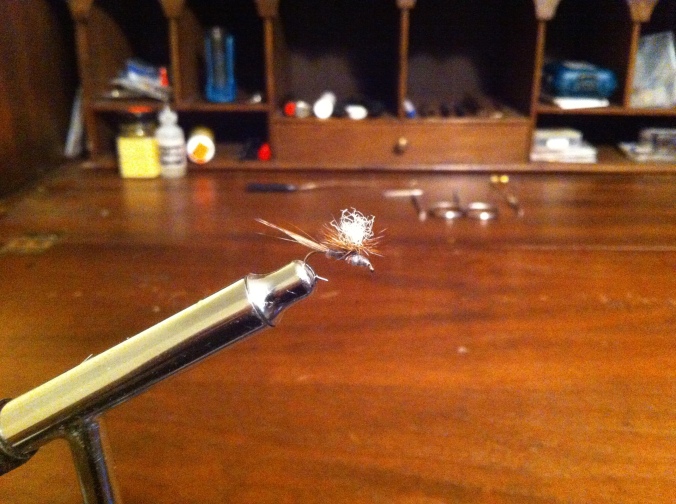
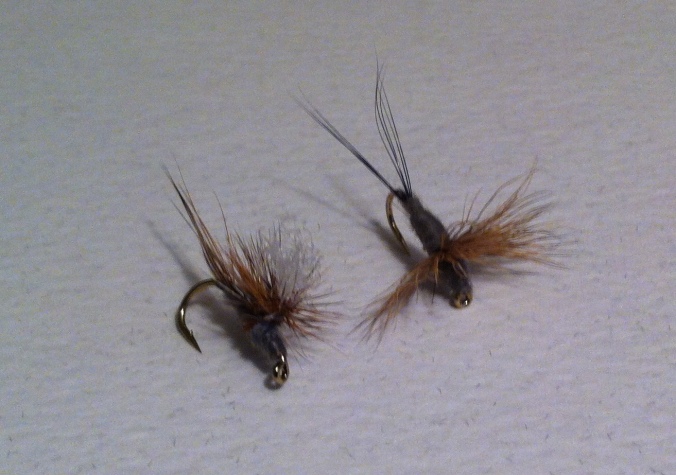
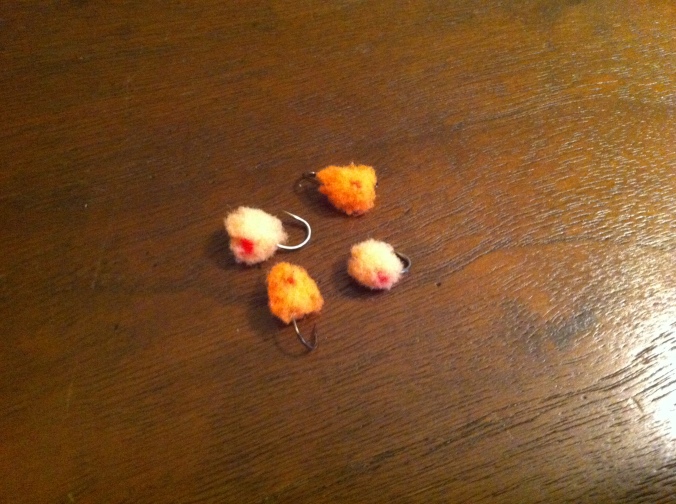

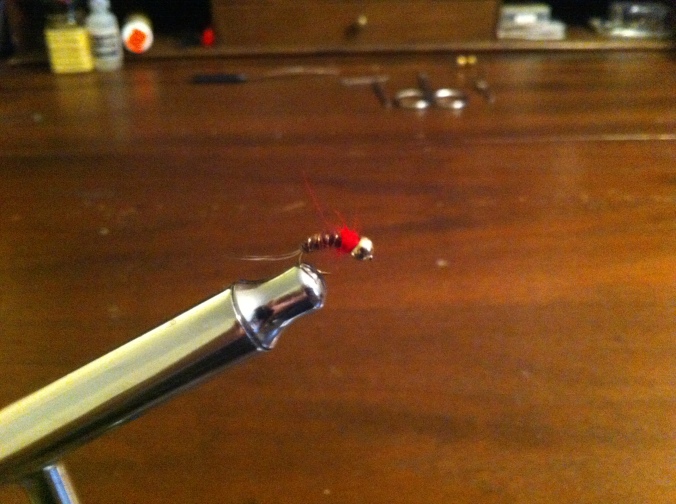
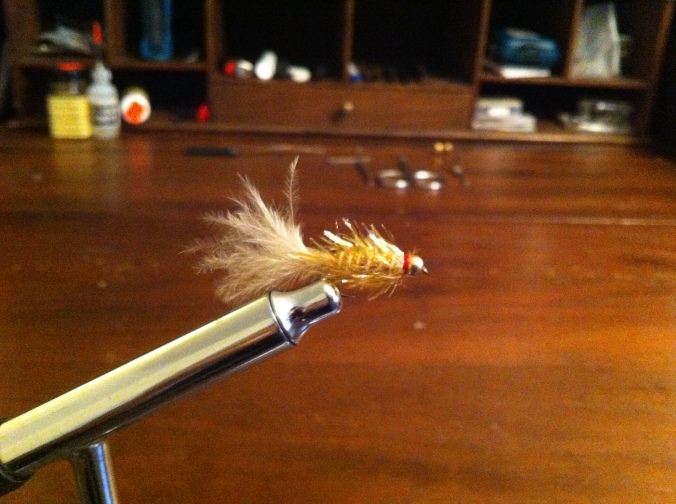



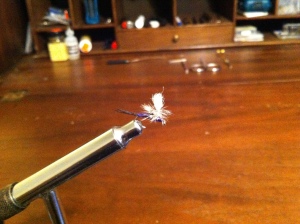
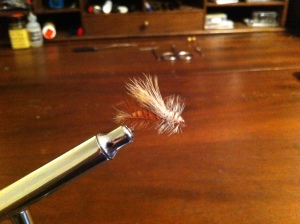
You had a great year in ’14, and here’s looking to another fine season in the months ahead. Thanks for your fly analysis here. These patterns are tops.
LikeLike